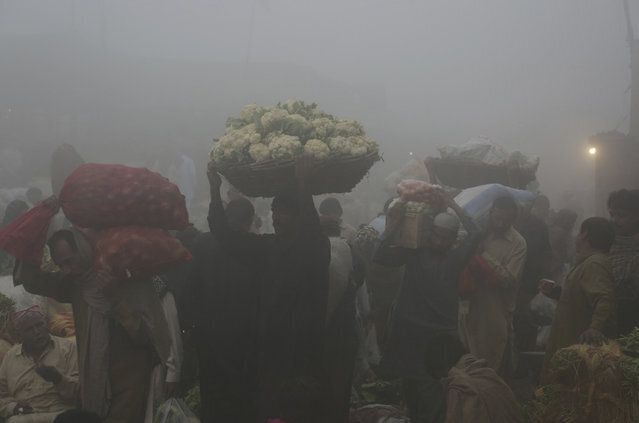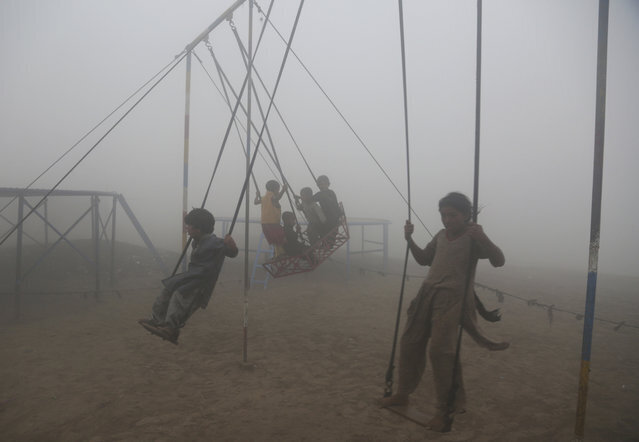COVID-19 Comes to Polluted Lahore
Lahore’s terrible air quality has prepared the ground for the novel coronavirus to do unspeakable amounts of harm. In coming out of this crisis, we must insist that the city’s deadly air pollution be cleaned up.
A vendor sells balloons amid heavy smog in Lahore. Photo: AFP via Bloomberg
The first cases of COVID-19 in Pakistan were confirmed on February 26th, right around the time the city of Lahore was emerging from what locals call its “smog season”. In recent years, the city has become accustomed to being shrouded in thick, putrid smog from October through February.
By April 13th, there were 458 confirmed cases of COVID-19 in Lahore and the exponential ascent of the outbreak seen elsewhere in the world was beginning to come into sight. As 12 million residents of Lahore get ready to face off against a disease that causes acute respiratory distress, the damage their lungs have sustained over the preceding months will likely play a role in increasing COVID-19’s fatality.
The air quality concerns that Lahore is dealing with are by no means unique to the city. Urban air pollution is a bane across much of the Indian subcontinent. Though alongside Delhi, Lahore is among not just the worst-affected major cities in the region, but the entire world.
Air pollution in the city is regularly far above safe thresholds. Levels of PM₂.₅ – i.e. airborne particles with a diameter of 2.5 micrometers or less – paint an especially alarming picture. This variety of fine particulate matter can pose a danger to human health even at low concentrations, as it can easily pass through the upper respiratory tract and make its way into the lungs and bloodstream.
While the World Health Organization has designated as unsafe anything above a daily mean of 25 micrograms/m³ of PM₂.₅, it also acknowledges that adverse health impacts can appear at “not greatly above the background concentration” of about 3 to 5 micrometers/m³. In a dataset compiled by the citizen-led Pakistan Air Quality Initiative, three-fourths of the more than 29,000 PM₂.₅ readings taken at monitoring stations in Lahore during 2018 exceeded 50 micrograms/m³. Some hundreds of readings exceeded 500 micrograms/m³!
Nov 2017: Labourers at a produce market in Lahore carrying vegetables amid heavy smog. Photo: K.M. Chaudary (AP) via AVAX
The virus and the pollutant
And there may be a link between air pollution and the impact of the virus. During the 2002-2003 SARS outbreak, a study found “a positive association between air pollution and SARS case fatality”, with high levels of pollution being correlated with as much as a doubling in the death rate caused by the virus.
“the interplay between COVID-19 and Lahore’s air pollution could be deadly ”
The extent of COVID-19’s global impact will ultimately be determined by a mix of environmental, social, and individual factors. Not until well after the ongoing pandemic is over will we be able to accurately disaggregate how any one factor helped to mitigate or heighten the harm done by the disease.
But what early research tells us about the link between air pollution and COVID-19 mortality is far from heartening: a Harvard University study based on data from the United States suggests that an increase in PM₂.₅ of just 1 microgram/m³ “is associated with a 15% increase in the COVID-19 death rate”. In other words, the interplay between COVID-19 and Lahore’s air pollution could be deadly indeed.
Nov 2017: Children ride swings in a playground surrounded by smog in Lahore. Photo: K.M. Chaudary (AP) via AVAX
The polemics of pollution
Of course, the air pollution in Lahore did not need COVID-19 to render it deadly. It has been deadly enough on its own terms. So much so that, in November 2019, Amnesty International suggested the deteriorating air quality in Lahore “raises significant human rights concerns,” pointing out that the right of the city’s inhabitants “to breathe clean air” was being violated. The group made the case that a great deal more needed to be done to raise public awareness about the extent of the harm caused by air pollution and it criticized the government for downplaying the crisis.
Government personnel often respond to concerns about air quality by moving the frame of discussion from the environment and public health to geopolitics: they suggest Lahore’s “smog season” is the result of the burning of crop residue and complain that, since much of this burning occurs across the border, the fault lies with India. (Zartaj Gul, the Minister of State for Climate Change, has even claimed that air pollution is “connected to the unconventional warfare we’re embattled in with our eastern neighbour”.)
The truth is crop residue burning is only one of many sources of air pollution that cities like Lahore are subject to. According to a 2014 World Bank report on Pakistan’s air pollution, vehicle emissions are the largest source of pollutants in the country’s urban centres. Numerous other sources exist, including “thermoelectric power plants, textiles, tanneries, sugar mills, cement, fertilizer, paper, brick kilns,” and so on.
And although “smog season” understandably elicits most of the public outcry about Lahore’s air quality, the smog is only a seasonal expression of bad air quality that exists in the city year-round. The smog is primarily the result, not of crop residue burning, but of a meteorological phenomenon known as temperature inversion. The phenomenon creates a blanket of warm air high above the city, trapping in cold winter air and helping the pollutants it contains mix into an awful airborne sludge.
Unless a means to manipulate meteorological patterns is on offer (it is not!), solving the problem of “smog season” will require tackling the year-round pollution problem faced by the city. This means that environmental and public health advocates must insist on framing the discussion in broader terms than has so far been the custom.
Public awareness must be raised about the detrimental impacts that pollution has, even when it is not possible, as during “smog season”, to see and taste the air. The media must be forced to challenge public officials when they make simplistic claims about crop residue burning and speciously try to blame India.
In fact, since the problem of air pollution is equally dire on both sides of the border, a network of advocates spanning the Lahore-Delhi corridor could be created to work on cleaning the air in the cities across the region. Such a network could share data, expertise, and resources while also coordinating lobbying efforts.
Jan 2019: A barber at a makeshift stall in Lahore gives his client a shave amid heavy fog and smog. Many vendors do not have a choice but to continue working under hazardous conditions, since they rely on daily earnings to barely sustain their families. Photo: Arif Ali (AFP)
From smog to socialism
Socialists have an important part to play in the fight against air pollution. We have to contribute to building an understanding of the links between the terrible air quality in Lahore and the capitalist development so often touted as bringing enrichment and progress (“taraqi”) to the city.
“the collective burdens the system produces are disproportionately borne by those who have gained the least from any taraqi [progress] it has brought”
Capitalism indeed creates wealth. Stupendous amounts of it, as the grotesque mansions and wasteful consumption habits of the upper layers of our society can testify. But as indicated by the fact that even humble varieties of Lahore’s inhabitants increasingly have access to private vehicles of some kind – from the ubiquitous motorcycles to steadily rising numbers of small, sputtering cars – the capitalist system has the capacity to raise living standards for significant numbers of people even in imperialized countries like Pakistan.
But capitalism has historically had a difficult time balancing private gain with collective wellbeing. Environmental problems like the air quality crisis and climate change are examples of the way in which capitalism’s drive to produce private wealth often leads to the creation of collective burdens.
It is well enough understood that the private wealth produced by capitalism is disproportionately appropriated by small numbers of people. Yet it is also the case that the collective burdens the system produces are disproportionately borne by those who have gained the least from any taraqi it has brought.
Mar 2020: A young boy sells masks during the government imposed nationwide lockdown to prevent the spread of Covid-19. Photo: Rueters via RFERL
Thus, the wealthy can remain relatively protected from Lahore’s air quality problems while riding around in their air-conditioned cars and holing away in their mansions on the city’s outskirts. But the majority of the city’s residents have few protections against air pollution. The least well-off, including those who sell trinkets on the roadside and those who labour in the outdoors, effectively inhabit a gas chamber for significant parts of the year.
The chatter on Pakistani WhatsApp networks has it that, given the rugged conditions in which so many of our people lead their lives and given the foul air that we all breathe, we must have developed immunities to the novel coronavirus that others around the world do not have. We are probably about to find out that the opposite is in fact the case.
Rugged conditions of life and foul air have likely prepared the ground for a COVID-19 crisis so far unseen elsewhere in the world. Pakistan will come out of the crisis deeply scarred and with a need to rebuild. We must insist that the rebuilding be done in a way that prioritizes collective wellbeing.
It is possible, for instance, to create environmentally-friendly public transit networks that prioritize collective wellbeing while also ensuring that people can travel around the city as needed. Doing so would go a long way towards helping us ditch our reliance on private vehicles while cleaning the air and clearing up the traffic jams that make traveling across the city such a chore.
The efforts meant to contain the spread of the virus have resulted in a slowdown of economic activity and produced a small window that allows us to see what the city’s air quality could perhaps be like (though, even now, the air is not as clean as it should be). We have a responsibility to ensure that the years that follow the COVID-19 crisis are not a return to normal.
Umair Muhammad has a BASc in Environmental Engineering and is a PhD candidate in Political Science. He produces Oats for Breakfast: An Ecosocialist Podcast. His Twitter handle is @umairupura.





